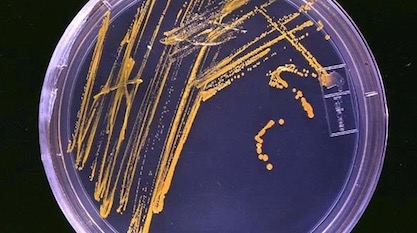 Education
Education
 Evolution
Evolution
Evolution and Bacteria — In the Classroom


Here’s an interesting article on how some teachers in Pennsylvania are presenting evolution. Neat, and ironic!
Instead of relying on their textbooks, students are learning about evolution by watching bacteria grow and change. That’s exciting! Sarah Schneider writes:
Sixteen-year-old Isabelle Walker sits at a black lab table wearing a lab coat. She stares down at a petri dish.
“We’re trying to see how different bacterial colonies grow in different conditions,” she said.
Walker and her classmates at Pittsburgh Public’s Science and Technology Academy in Oakland know that the experiment they’re conducting will show that bacteria adapt.…
The students add a common strain of bacteria to a test tube along with a plastic bead. Over a few days, they transfer the bead to a new test tube. Only the bacteria that attach to the bead transfer to the tube.
The students work in groups and follow written instructions. They make a few mistakes along the way.
Jay Brown, 15, is in Walker’s group. The research question they develop together asks if there will be a difference between biofilm production in the irregular colonies and the control colonies.
The bacteria that attach to the beads have done so by producing biofilm. The mutants multiply rapidly and produce new colonies that look different because of their increased biofilm production.
That sounds like a cool classroom experiment. The teacher mentions this method is much more engaging for students than just hearing a lecture. I bet it is! But the students would benefit from hearing the rest of the story.
Devolution in Action
As Michael Behe writes in Darwin Devolves, drawing on Richard Lenski’s research with E. coli, bacteria adapt to challenging circumstances generally by breaking genes, degrading their genome rather than evolving in the creative way we think of when we think of, well, evolution. That’s the case not only with bacteria but with evolution in general. You could take a look at the exchanges at Evolution News with Behe’s critics about polar bears. See the Criticism & Response page at the Darwin Devolves website.
No molecules-to-man process is in evidence here. It’s not large scale morphological change from one life form to another.
What these kids are really seeing is a hint as to the limits of adaptive mutation. They are being told this is evolution in action. If they watched long enough, like Richard Lenski, what they’d see would be devolution.
Photo: A petri dish, by U.S. National Oceanic and Atmospheric Administration, via Wikimedia Commons.
